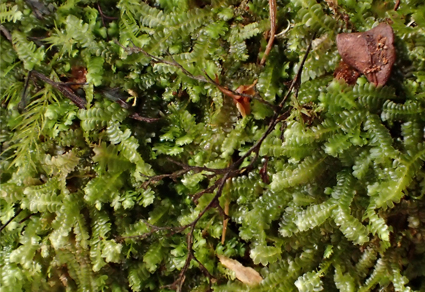Abstract
A computer-assisted identification (CAI) key, created by the XPer3 software, is presented based on the description of the genus Bazzania (Lepidoziaceae) in Madagascar. The knowledge database is presented along with automatically generated keys and static keys, which are both produced by the software. Although these tools are powerful and user-friendly, expert competence is essential both for building the database and providing relevant keys.
Downloads
Download data is not yet available.
References
- Fulford, M.H. (1959) Studies on American Hepaticae. 7. A supplement to "The genus Bazzania in Central and South America". Bulletin of the Torrey botanical club 6: 308–341, 399–412. https://doi.org/10.2307/2482503
- Gray, S.F. (1821) A Natural Arrangement of British Plants 1: i–xxviii, 1–824. pi. 1–21. London.
- Grolle, R. (1960) Notulae hepaticologicae I. - II. - III Revue Bryologiue et Lichénologique 29: 207–211.
- Jones, E.W. (1975) African hepatics. XXVII. Bazzania. Journal of Bryology 8: 299–316. https://doi.org/10.1179/jbr.1975.8.3.299
- Jones, E.W. (1980) African hepatics. XXXII. Some little-known species and extensions of range. Journal of Bryology 11: 311–323. https://doi.org/10.1179/jbr.1980.11.2.311
- Kerner, A., Bouquin, S., Portier, R. & Vignes Lebbe, R. (2021) The 8 Years of Existence of Xper3: State of the art and future developments of the platform. Biodiversity Information Science and Standards 5: e74250. https://doi.org/10.3897/biss.5.74250
- Khotimperwati, L., Kasiamdari, R., Santosa & Daryono, B.S. (2018) Bazzania Gray (Lepidoziaceae, Marchantiophyta) in Central Java, Indonesia. Biodiversitas 19: 875–887. https://doi.org/10.13057/biodiv/d190316
- Lebbe, J. (1991) Représentation des concepts en biologie et médecine. Introduction à l’analyse des connaissances et à l’identification assistée par ordinateur Thèse de doctorat, Université Pierre et Marie Curie, Paris, 281 pp.
- Marline, L., Andriamiarisoa, R.L., Bardat, J., Chuah-Petiot, M., Hedderson, T.A.J., Reeb, C., Strasberg, D., Wilding, N. & Ah-Peng, C. (2012) Checklist of the bryophytes of Madagascar. Cryptogamie, Bryologie 3: 199–255. https://doi.org/10.7872/cryb.v33.iss3.2012.199
- Onraedt, M. (1977) Bryophytes des îles mascareno-malgaches et Seychelles. III. Hepaticae: Bazzania. Bulletin du Jardin Botanique National de Belgique 47: 139–144. https://doi.org/10.2307/3667988
- Pócs, T. (1994) Taxonomic results of the BRYOTROP expedition to Zaire and Rwanda. 27. Lepidoziacaeae, II. Tropical Bryology 9: 123–130. https://doi.org/10.11646/bde.9.1.16
- Pócs, T. (2010) Bazzania orbanii (Lepidoziaceae), a new species from Madagascar. East African bryophytes, XXVIII. Acta Biologica Plantarum Agriensis 1: 15–22.
- Meagher, D.A. (2019) A synopsis of the genus Bazzania (Marchantiophyta: Lepidoziaceae) in Australia. Australian Systematic Botany 32: 310–362. https://doi.org/10.1071/SB18025
- Renauld, F. & Cardot, J. (1891) Contributions à l’étude des muscinées des iles Austro-Africaines de l’Océan Indien. Revue Bryologique 18: 56.
- Sass-Gyarmati, A. (2017) Bazzania konratiana sp. nov. (Marchantiophyta: Lepidoziaceae) from Madagascar. Cryptogamie, Bryologie 38: 119–124. https://doi.org/10.7872/cryb/v38.iss2.2017.119
- Sass-Gyarmati, A. & Pócs, T. (2019) A new combination in Lepidoziaceae (Marchantiophyta). Phytotaxa 403 (2): 142. https://doi.org/10.11646/phytotaxa.403.2.8
- Sass-Gyarmati, A. & Pócs, T. (2021) A new taxon of Bazzania (Lepidoziaceae) collected in Manongarivo Special Reserve, NW Madagascar. Frahmia 24: 1–5.
- Sass-Gyarmati, A. & Reeb, C. (2021) The present status of Bazzania curvidens Steph. (Lepidoziaceae). Acta Biologica Plantarum Agriensis 9: 32–35. https://doi.org/10.21406/abpa.2021.9.1.32
- Sass-Gyarmati, A. & Gradstein, S.R. (2023) On the status of Bazzania madagassa (Marchantiophyta: Lepidoziaceae) from Madagascar. Phytotaxa 613 (1): 75–78. https://doi.org/10.11646/phytotaxa.613.1.8
- Söderström, L., Hagborg, A., von Konrat, M., Bartholomew-Began, S., Bell, D., Briscoe, L., Brown, E., Cargill, D.C., da Costa, D.P., Crandall-Stotler, B.J., Cooper, E., Dauphin, G., Engel, J., Feldberg, K., Glenny, D., Gradstein, S.R., He, X., Hentschel, J., Ilkiu-Borges, A.L., Katagiri, T., Konstantinova, N.A., Larrain, J., Long, D., Nebel, M., Pócs, T., Puche, F., Reiner-Drehwald, E., Renner, M., Sass-Gyarmati, A., Schäfer-Verwimp, A., Segarra-Moragues, J., Stotler, R.E., Sukkharak, P., Thiers, B., Uribe, J., Váňa, J., Wigginton, M., Zhang, L. & Zhu, R.-L. (2016) World checklist of hornworts and liverworts. PhytoKeys 59: 1–828. https://doi.org/10.3897/phytokeys.59.6261
- Spruce, R. (1890) Hepaticae bolivianae, in Andibus boliviae orientalis. Memoirs of the Torrey Botanical Club 1 (3): 113–140.
- Trevisan de Saint-Léon, V.B.A. (1877) Schema di una nuova classificazione delle epatiche Memorie del Reale Istituto Lombardo di Scienze e Lettere, Serie 3, Classe di Scienze Matematiche e Naturali 4: 414.
- Vignes-Lebbe, R., Chesselet, P. & Diep Thi, M.-H. (2016) Xper3: new tools for collaborating, training and transmitting knowledge on botanical phenotypes. In: Rakotoarisoa, N.R., Blackmore, S. & Riera, B. (Eds.) Botanists of the twenty-first century: roles, challenges and opportunities. UNESCO, Paris, pp. 228–239.
- Wigginton, M.J. (Ed.) (2004) E.W. Jones's liverworts and hornworts Flora of West Africa. Scripta Botanica Belgica (Vol. 30), National Botanic Garden of Belgium, Meise, 443 pp.
- WFO (World Flora Online) (2023) [https://www.worldfloraonline.org/] Version 2023.


